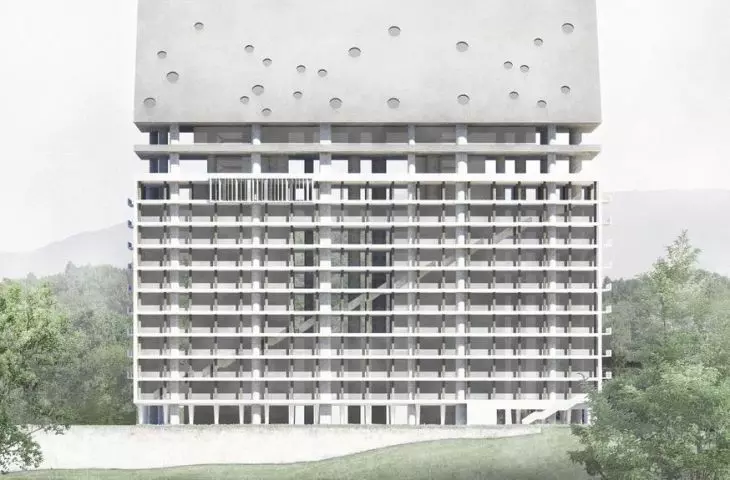Agnieszka Kępa, a graduate of the Faculty of Architecture at the Cracow University of Technology, attempted in her thesis to adapt the ruins of the Stalownik sanatorium , located near Bielsko-Biała, into an exhibition space and archive. Her project won this year's edition of the BDA-SARP Polish-German Integration Award.
The award-winning work "Archive of the Utopia of Rationalism in Architecture. Adaptation of the ruins of the Stalownik sanatorium in Mikuszowice Krakowskie" was made under the direction of Dr. Marcin Charciarek.
The author added a new space to the former building
© Agnieszka Kępa
As we read in the jury's justification - the winning project questions the monumentality of contemporary ruins. By adding seemingly simple modules, the abandoned hospital is opened up as an exhibition space and supplemented with an archive building. Symbolically, the archive supports the roof of the hospital, with the statically necessary pillars breaking through the ceilings of the original building and thus creating new spatial situations. The treatment of the existing building, whose structure is preserved, is at once delicate and radical. The ambivalent, precarious monumentality of the original state is strengthened and made real through adaptation.
For more information on the Annual Polish-German Integration Award BDA - SARP 2022 and all the awarded works, click here.
Stalownik is located in Mikuszowice Krakowskie
© Agnieszka Kępa
history of Stalownik
The Stalownik sanatorium and hospital was built in the 1960s in Mikuszowice Krakowskie. The original design was a utopian idea of a treatment center intended mainly for steelworkers and miners from southern Poland, who could regain their health surrounded by nature and with access to fresh air. Situated on a hill and surrounded by dense forest, the building overlooks the panorama of the Silesian Beskid. The building is an example of functionalist architecture, whose structural layout is based on an orthogonal grid of steel columns. The fully glazed southern elevation provided excellent views and sunlight. The monumental body of the building stands out clearly against the soft forms of the natural landscape," says Agnieszka Kepa about the building's history.
The sanatorium is clearly visible from the valley where the expressway and the railroad run, as well as from the hills tens of kilometers away - Stalownik is an integral part of the landscape.
southwest elevation of the building
© Agnieszka Kępa
The building has been out of use for twenty years and is subject to slow decay, and in 2019 its demolition began. For pragmatic reasons, the hospital had to be relocated to a building closer to the city center, while the Steelworker still has not gained a replacement function. Today, as a ruin, the building evokes extreme reactions. On the one hand it arouses resentment, on the other hand it is an object of fascination. One can see many contradictions in it. It is too new to be a monument, but at the same time too dilapidated to serve its original function. Although theoretically the building has no function now, in practice it has become a vertical park and an object of interest for enthusiasts of Brutalist architecture. Despite bans, the Steelworker continues to be visited and explored. It has transformed from a utilitarian object into a form of aesthetic attraction, which has become its new informal role," says the award winner.
interior of the exhibition space
© Agnieszka Kępa
Utopia archive
The main idea behind the adaptation of the Steelworker ruin was not to restore its original qualities, but to take advantage of those qualities it has gained over the past twenty years. The new function of the building, as the author called it - the Archive of Utopia of Rationalism in Architecture, is a reference to the history of the Steelworker, which is an example of many other similar utopian projects that have not stood the test of time. An important element for the architect was to preserve the function of a vertical park, always accessible to visitors.
The steelworker towers over the city
© Agnieszka Kępa
The architectural concept emphasizes and reinforces the formal features that the building already has. With the help of the new volume, the presence of the Stalownik is further emphasized in the Beskid skyline and at the same time signals that the building has gained a new function and meaning, the author explains.
minimal changes
The proposed adaptation involves leaving the Steelworker as an exhibition space for the collections collected in the archive and making only minimal changes to the building to enable its use. In order to allow users to explore the building independently of the operation of the archive institution, the author set back the glass facade by three meters, and in the free space introduced an external staircase that diagonally cuts through the building's facade.
The new volume is arranged on concrete pillars
© Agnieszka Kepa
She placed thearchive in a new volume, doubling the original height of the Steelworker. Elevated above the existing building, the new volume is supported on irregularly spaced concrete columns that provide the archive with an independent structure. The massive circular columns contrast sharply with the regular grid of steel columns of the existing building and clearly mark the newly introduced function. At the same time, according to the architect, they make the Steelman difficult to explore, preserving the qualities it had as a ruin - a difficult fortress to explore, which requires effort to explore. The roof slab was supported by a grid of columns and braced by ribs running through its slope. In addition, the structure was reinforced with coffered ceilings located on the first two floors of the archive.






















































